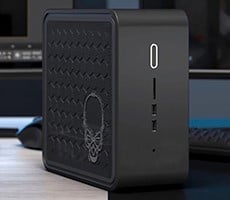Intel Clarkdale Core i5 Desktop Processor Debuts
Performance Summary: To Core i5 661 is the fastest Intel dual-core processor we've ever tested, until the Core i5 670 lands in the lab that is. But that's a story for another day. Looking back at our numbers, it's clear that the Core i5 661 is a strong performer. Although the chip sports only two physical execution cores, the processor's ability to leverage HyperThreading to process up to four threads makes it act like a quad-core in some circumstances. Overall, the Core i5 661's performance falls somewhere in between a Core 2 Quad Q9650 and Q9400 in real-world application performance, although in situations where only one or two threads are being executed the Core i5 661 can be significantly faster thanks to its more advanced cores and high frequency--i.e. in the LAME MT benchmark.
When working in conjunction with its integrated Intel HD Graphics engine, the Core i5 661 also performs well, and compares favorably to AMD's top-of-line Phenom II, when it's paired to the AMD 785G IGP. Although AMD's platform pulled ahead in the low-res ET:QW test, Intel's solution led everywhere else. In our multimedia testing, the Core i5 661 + Intel HD Graphics combo also handled SD and HD video playback exceptionally well.
![]()
The Core i5 661 is an interesting animal. It's a dual-core processor that performs like a quad-core, for the most part anyway. Thanks to its high-clocked execution cores, which also support Hyper-Threading, desktop application performance is very good. We also feel that the processor's integrated Intel HD Graphics core is Intel's best graphics solution to date. While it may not be able to burn through modern 3D gaming titles, the Intel HD Graphics engine is more than powerful enough for typical office duties and it performed very well with a variety of multimedia workloads. The Intel HD Graphics engine also lived up to its name, and handled a variety of HD videos with aplomb.
As you can see, the Core i5 661 is near the top of the heap, with only the i5 670 ranking higher. The Core i5 661 is priced at $196 in 1K quantities, which is identical to the i5 660. Although priced the same, the 661 differs from the 660 in that the 661's integrated Intel HD graphics engine is clocked higher (900MHz vs. 733MHz), hence the chip's higher TDP. The Core i3 series processors you see listed here, while also being clocked lower, lack support for Intel's Turbo Mode technology--so that clock speeds you see are the clock speeds that you get.
Although we focused on the Core i5 661 in this article, Intel is actually announcing a number of new Clarkdale-based processors today. Here's the complete breakdown of Clarkdale-based desktop processors that are on the way...

Strictly talking in terms of the technology, Clarkdale is a very cool product. Performance is very good, the chips are power friendly, and they represent the bleeding edge of desktop computing (32nm process, on-chip graphics, etc.) But their naming convention is definitely going to confuse some consumers and pricing is difficult to understand. As it stands now, Intel has quad-core and dual-core Core i5 processors, some with and some without integrated graphics. And some of the chips have faster clocked IGPs than others. With regard to pricing, these new Core i5 chipst are more affordable and faster than the fastest Wolfdales, and they also offer more features, but at the same time they're pricier than AMD's fastest quad-core Phenom IIs, which perform better in many circumstances. We can see why these new chips are priced as they are, but would have been more impresses had they been somewhat more affordable.
Ultimately though, Intel should be commended for fusing their best graphics engine to date with their most cutting edge dual-core processor. Clarkdale-based Core i5 and Core i3 processors may not break any benchmark records, but they're excellent options for mainstream, lower-power systems, well suited to a wide-range of usage models. If you're looking for components to build a fast, affordable dual-core rig, and will be happy with integrated graphics, your search may be over.
|
|
|
|
|







